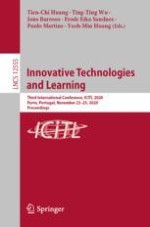2020 | OriginalPaper | Buchkapitel
Effective Utilization of the Constructivist Web-Based Learning Environment Model to Enhance Human Learning Efficiency Based on Brain-Based Learning
verfasst von : Wanwisa Wannapipat, Sumalee Chaijaroen
Erschienen in: Innovative Technologies and Learning
Aktivieren Sie unsere intelligente Suche, um passende Fachinhalte oder Patente zu finden.
Wählen Sie Textabschnitte aus um mit Künstlicher Intelligenz passenden Patente zu finden. powered by
Markieren Sie Textabschnitte, um KI-gestützt weitere passende Inhalte zu finden. powered by
